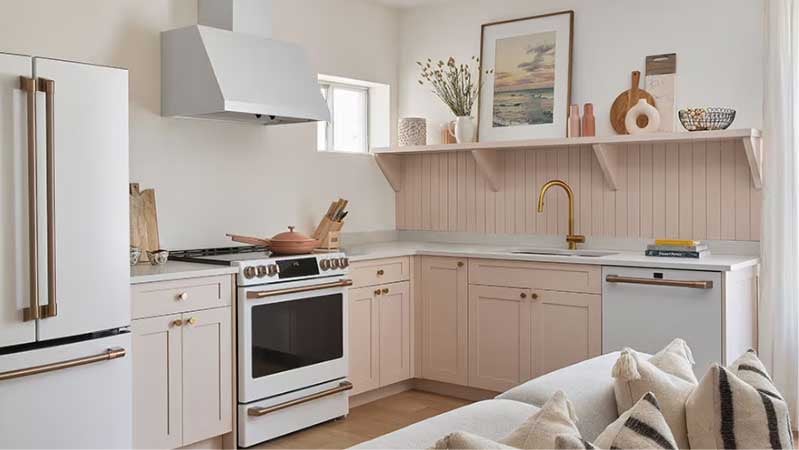
So, you’re ordering a new pro range because you cook a lot for friends and family.
You choose the right hood with the proper capture area and a straight duct run.
Then you’re convinced to do this:

Guess what?
It won’t work.
Then again, most vents don’t adequately vent either, but that’s a separate topic.
In this article, you’ll learn the correct height to hang your range hood based on hood type, along with all the other common ventilation problems.
Note: That opening picture was the front page of the Café webhttps://shophjr.com/. The kitchen was designed for an important influencer. Hopefully, she’ll be eating out.
The Basics of Ventilation
Ventilation involves four key elements: CFM, capture area, duct size, and duct run.
Let’s look at each of these aspects.
CFM
CFM stands for cubic feet per minute, indicating the volume of air extracted per minute. A blower rated at 900 CFM removes 900 cubic feet of air every minute, which is about the air volume in a small room.
The required CFM varies based on your cooking style and stove setup.
If you frequently grill, fry, or use a griddle or wok, a range of 900 to 1500 CFM is essential to effectively remove the odors and grease produced during high-volume cooking.
For simpler tasks like boiling water, a minimum of 400 CFM may suffice.
Types of Blowers
There are three types of blowers:
- Internal Blowers: These are pre-installed within the hood, making them easier to maintain, but they tend to generate more noise.
- External Blowers: Located outside your home, these blowers offer higher CFMs and quieter operation, though you’ll still hear the airflow through the duct. However, they can be inconvenient to repair in winter, and their bulky stainless-steel housing doesn’t look great on the exterior of your house.
- In-Line Blowers: Installed along the duct run, in-line blowers provide the quiet operation of external blowers without requiring a large motor outside your home. Be sure to incorporate an access door for potential servicing if you choose an in-line blower.
Capture Area
Understanding capture is crucial for adequate ventilation.
Capture refers to the dimensions of the hood, including its height, width, and depth. The hood first chambers the smoke, then expels it from your home.
For high-volume cooking, choose a hood with a minimum depth of 23 inches.
Why?
The front left and right burners, which you’ll likely use most, are about 22-23 inches from the base.
Note: Most hoods don’t vent properly because they lack sufficient depth. Over-the-range microwaves, most hoods, and downdrafts don’t have the necessary depth to effectively vent emissions.
Duct Run
Ideally, your vent duct should be no longer than 30 feet. Longer duct runs reduce exhaust flow, as do any transitions or elbows in the duct.
Each elbow turn is equivalent to approximately 6-8 feet of ducting.
If your duct run includes more than one elbow turn, you should reconsider the duct pathway.
Vertical, straight, and short duct runs are best, followed by short horizontal routes.
Duct Size
Larger ducts allow for the removal of more smoke, so at least a 6-inch diameter is recommended. Larger CFM blowers may require 8- or 10-inch ducts.
The ducts should be made of solid metal. Flexible ducts can trap grease in their joints, which violates building codes in several states.
Note: I remember when people used dryer ducts—not a smart choice, even back then.
Pro Tip: Start your hood at least 3 minutes before you begin cooking to get the air flowing. Don’t wait until the kitchen is filled with smoke.
Make-Up Air
Any new vent installation exceeding 400 CFM requires an equivalent fresh air return.
Incorporating make-up air into your HVAC plan is straightforward during new construction.
However, Massachusetts code stipulates that, for retrofits, the make-up air must be positioned 10 feet away on the oppohttps://shophjr.com/ wall.
With a solid foundation in ventilation principles, let’s shift our focus to understanding the critical aspects of range hood placement.
Read More: How to Vent Your Kitchen Range
The Importance of Range Hood Placement
A range hood is essential for eliminating cooking byproducts such as smoke, steam, grease, and lingering odors.
However, there’s more to consider.
Many stoves today have significantly higher output than they did 30 years ago. The process of burning fat, combined with the enhanced output of modern burners, creates a semi-toxic mix of chemicals:
Carbon monoxide, nitrogen dioxide, formaldehyde, and particulate matter are all emitted into your home.
At the same time, homes are now built to be more airtight, meaning that this toxic brew stays in your home longer.
As a result, indoor air quality in homes is often worse than outdoor air quality.
Therefore, choosing the right ventilation and ensuring proper placement is critical.
Now that we understand its importance, let’s explore the key factors that influence the height of your range hood.
Factors Influencing Range Hood Height
When determining the best height for your range hood, several factors must be considered:
Cooking Surface Type
The type of cooking surface you have—whether a gas range, electric stove, or induction cooktop—plays a significant role in determining the ideal range hood height.
Gas ranges produce more heat, smoke, and combustion byproducts, so a lower hood placement is often recommended.
In contrast, electric stoves and induction cooktops generate less smoke and heat, allowing for slightly higher placement.
Ceiling Height
Ceiling height matters.
In spaces with high ceilings, you may need to adjust the height of your range hood to properly vent your kitchen range.
Remember, you want to strike a balance between capturing cooking byproducts and allowing space for steam and smoke to rise.
Industry Guidelines and Recommendations
To help you navigate your options, industry organizations like the National Kitchen & Bath Association (NKBA) and range hood manufacturers have established general guidelines for range hood height.
While these are just starting points, they provide valuable insights into achieving optimal ventilation.
Gas Stovetop: For a traditional gas stovetop, it’s often recommended to hang the bottom of the hood between 24 and 30 inches above the cooking surface.
Electric and Induction Stovetops: Electric stovetops and induction stovetops can tolerate slightly higher range hood placement, typically between 28 and 36 inches.
Keep in mind that these figures are not set in stone—your kitchen’s unique layout may require slight adjustments.
The Best Range Hood Height for Different Types of Ranges
Let’s break down the ideal range hood height based on the type of cooking surface you have:
Gas Stovetops
Gas ranges are culinary powerhouses, producing more heat and combustion byproducts.
Consider placing your range hood 24 to 30 inches above the cooking surface to ensure adequate capture and ventilation. If you’re using a custom wood hood, 30 to 36 inches would be ideal.
Electric and Induction Stovetops
Electric ranges and induction cooktops generate less heat and smoke than gas ranges, giving you some flexibility in range hood placement.
Aim for a height of 28 to 36 inches for the best ventilation without compromising aesthetics.
Recommendations By Hood Types
Over-the-Range Microwaves
Over-the-range microwaves are typically installed 30 inches above the cooking surface, leaving about 13-14 inches of space between the microwave and your stovetop.
This provides limited space between the range and hood.
Note: Over-the-range microwaves are not a good choice for ventilation.
Pro Range Hoods (High CFM)
Pro range hoods are designed to ventilate professional ranges with larger blowers and higher CFM levels.
If you’re placing a stainless-steel hood above a professional range, it should be installed between 30 and 36 inches from the cooking surface.
Pro Tip: If you’re using a custom wood hood, check the range requirements, as they can vary from 30 to 40 inches.
Ceiling Blowers
Ceiling blowers are a newer option for maintaining unobstructed views in your kitchen.
However, we’re skeptical of their usefulness. These hoods must be installed 4 to 7 feet above the cooking surface.
Note: These hoods are often shown in dramatic pictures, often on cathedral ceilings. The smoke and fumes will dissipate before they are exhausted.
Island Hoods
Island hoods are the best way to vent your stove or stovetop on an island.
If using a pro range, they should be installed 30 to 36 inches above the cooking surface.
For a traditional range, 24 to 30 inches is usually recommended.
Pro Tip: When installing an island hood, oversize it by 6 inches to provide more capture area.
Under Cabinet Range Hoods
Under-cabinet range hoods are the most common. For a traditional range, they should be installed 18 to 24 inches above the cooking surface.
For a professional range, install them 30 to 36 inches above the surface.
Note: If you’re taller, consider mounting the range hood higher.
Installation Process and Tips
You’re now ready to tackle the installation process. Follow these steps to ensure a smooth setup:
- Measure and Mark: Measure the height you’ve chosen and mark the spot on the wall where the bottom of the range hood will be positioned. Use a level to ensure accuracy.
- Prepare the Area: If your range hood requires venting through an exterior wall, make sure you have the necessary tools and materials.
- Anchoring and Support: Range hoods can be heavy, so proper anchoring and support are crucial. Make sure you’re attaching the hood securely to studs in the wall.
- Ventilation Considerations: If your range hood requires external ventilation, ensure you’re positioning it to allow for easy duct connection.
Common Range Hood Installation Mistakes to Avoid
As you prepare to install your range hood, be aware of these common mistakes that can hinder its performance:
- Placing It Too High: Hanging the range hood too high can reduce its efficiency, as it may struggle to capture rising smoke and odors.
- Ignoring Manufacturer Guidelines: Don’t give the manufacturer a reason to void your warranty by neglecting their guidelines.
- Neglecting Anchoring: Improper anchoring could lead to a range hood disaster—not something you want happening mid-cooking session.
Personalization and User Preferences
While guidelines provide valuable insights, don’t forget that you’re the chef in your kitchen. Personal comfort and aesthetics matter.
If you’re particularly tall, you might opt for a slightly higher range hood for better visibility.
Alternatively, you might choose a slightly lower placement if you prefer low-hanging pendant lights. Striking the right balance between functionality and design is key.
As mentioned, CFM depends on your stove and how you cook.
Consulting Professionals
If you’re feeling overwhelmed or unsure, consider consulting professionals.
Kitchen designers, contractors, and appliance experts can offer personalized advice based on your kitchen’s layout and specific needs.
Or better yet, read our Ventilation Buying Guide. I enjoyed writing it because it provides concrete answers to one of the biggest problems in your kitchen.
Key Takeaways
In conclusion, the height at which you hang your range hood is a decision that shouldn’t be taken lightly.
Proper ventilation is essential, as exhausting high-output ranges will have a significant impact on the air you breathe in your home.
So, measure twice, hang it once, and enjoy your new kitchen.
Additional Resources
Get the Yale Ventilation Buying Guide with features, specs, and inside tips for every brand and hood type. Well over 1 million people have read a Yale Guide.






